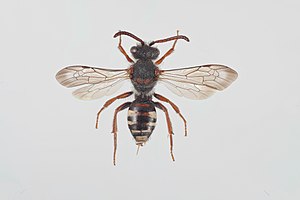Nomada obscura
| Nomada obscura | ||||||||||||
|---|---|---|---|---|---|---|---|---|---|---|---|---|

Nomada obscura |
||||||||||||
| Systematics | ||||||||||||
|
||||||||||||
| Scientific name | ||||||||||||
| Nomada obscura | ||||||||||||
| Zetterstedt , 1838 |
Nomada obscura is a bee from the family of Apidae .
features
The bees are 7 to 9 millimeters long. The head and thorax of the females are black and drawn in red. The tergites are a little red on the disk with white spots, otherwise black. The mandibles have an additional tooth at the end. The labrum has two teeth in front. The third antennae is shorter than the fourth. The rails ( tibia ) of the hind legs are blunt at the end and have several dark, tightly spaced small thorns. The males are similar to the females, but only the mandibles and the undersides of the antennae flagella are red, the tergites are occasionally slightly reddish brown.
Occurrence and way of life
The species is common in northern and central Europe. The animals fly from the beginning of April to the end of June, according to Paul Westrich from the end of March to the end of April. They parasitize Andrena ruficrus , but this is the only known species. The animals can be found on the nest colonies of their hosts shortly after the snow has melted .
The nectar sources used are primarily early-flowering willow species , but also coltsfoot or meadow dandelion and the like.
supporting documents
- Paul Westrich : The wild bees of Germany , 2., act. Ed., Ulmer, 2019, p. 686.
Felix Amiet, M. Herrmann, A. Müller, R. Neumeyer: Fauna Helvetica 20: Apidae 5 . Center Suisse de Cartographie de la Faune, 2007, ISBN 978-2-88414-032-4 .